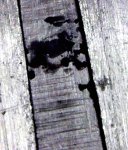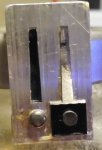boxplayer4000
Prolific poster
Reed Corrosion.
While checking a quality accordion with Antonelli reeds, which had not been played over a long period, an unusual gritty dust was seen in the upper treble reeds. I removed this as best possible and the reeds sounded fine with the exception of a top G Sharp range 6. The pitch had dropped a full semi-tone to G and the tip of the reed was raised. A notch/crack on one side of the reed was visible with a light at the back of the reed and what looked like corrosion mainly on the outer surface. The corrosion, or waisting of the reed, was so advanced that cleaning or removal of the corrosion was not going to save the reed.
Reed corrosion is not unusual and in most cases can be dealt with with emery cloth and perhaps WD40. The corrosion, if that’s what it was, on my reed, was different in that it was much more local and intense.
Most of the damage is about 2/3 of the way up the reed and I’ve tried to photograph it. Any thought please?
While checking a quality accordion with Antonelli reeds, which had not been played over a long period, an unusual gritty dust was seen in the upper treble reeds. I removed this as best possible and the reeds sounded fine with the exception of a top G Sharp range 6. The pitch had dropped a full semi-tone to G and the tip of the reed was raised. A notch/crack on one side of the reed was visible with a light at the back of the reed and what looked like corrosion mainly on the outer surface. The corrosion, or waisting of the reed, was so advanced that cleaning or removal of the corrosion was not going to save the reed.
Reed corrosion is not unusual and in most cases can be dealt with with emery cloth and perhaps WD40. The corrosion, if that’s what it was, on my reed, was different in that it was much more local and intense.
Most of the damage is about 2/3 of the way up the reed and I’ve tried to photograph it. Any thought please?



